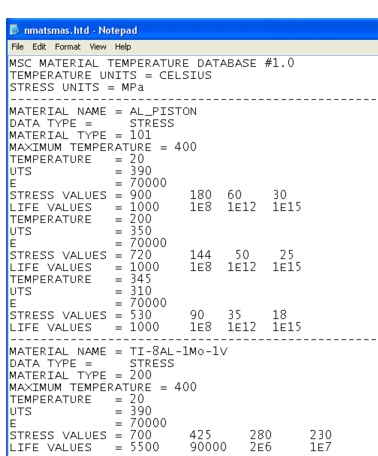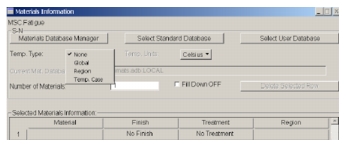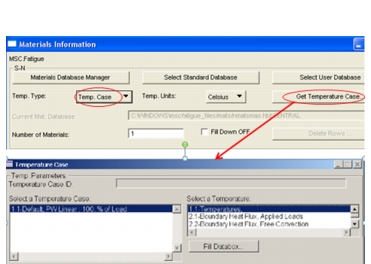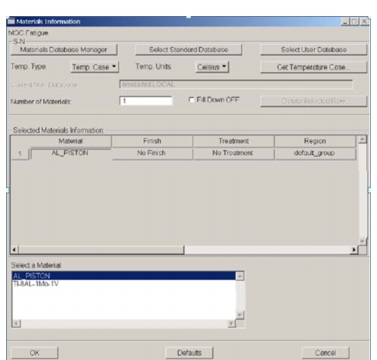XXXXXXXXXXXXXXXXXXXXXXXXXXXXXXXXXXXXXXXXXXXXXXXXXXXXXXXXXXXXXXXXXXXXXXXXXXXXXXXXXXXXXXXXXXXXXXXXXXXXXXXXXXXXXXXXXXXXXXXXXXXXXXXXXXXXXXXXXXXXXXXXXXXXXXXX''"> Materials with Temperature Dependent Properties
MSC.Fatigue can calculate fatigue damage and life for materials with temperature dependent properties, using an ASCII materials database (nmats.htd). Users can edit and add their own materials data, by copying nmats.htd from the installation directory to their own run directories. The following printout from the ASCII database shows the properties of one material named AL_Piston.

Temperatures may be assigned to the analysis globally, by group (region) or extracted from a Thermal Case in the Patran database.
The temperatures are steady state (i.e. constant with time) and do not include time varying or creep effects, but may vary spatially across the FE model. Currently, temperature corrected fatigue analysis may only be performed with S-N (Stress Life) and E-N (Strain Life) analysis only. Optimization and Fast Analysis options are not currently available.
Material Information
Temperature assignments to the analysis entities are made on the Material Information form. There are 4 methods: Global, Region, Temp. Case, or ASCII Temp to assign temperatures to the analysis group(s) from the Temp Type pull down menu. Global assigns the same temperature to all the analysis groups. Region allows the user to specify temperatures on the analysis groups on the material form. Temp. Case extracts the temperatures from a Thermal analysis case from the Patran database. ASCII Temp requests that the user assign a default global temperature and then specify the name of the TDS file to use in overwriting the temperature for certain nodes. For Global, Region, Temp. Case, or ASCII Temp, an ASCII materials database is used (nmats.htd) that is copied form the installation directory to the user’s run directory, to facilitate editing and addition of material data. You can click on the Materials Database Manger button to view the .htd file with a text editor. Just like other analysis types, the list of available materials will be displayed in the list box on the material form. The regular Material database is displayed via PFMAT if the default Temp. Type of None is selected.

If the
Temp. Case is selected from the
Temp. Type pull-down menu, a
Get Temperature Case button appers. Clicking on the
Get Temperature Case button brings the
Temperature Case selection form for selecting a temperature case.

After selecting the temperature case, Users can select a material by clicking the
Material cell on the
Material Information form.





